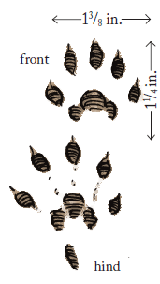Wildlife - Species

Species Specific Regulations
Mink
Licenses: Hunting License required.
Limits: Weapon restrictions according to game zones please check for Limitations.

Mink tracks
Mink (Mustela vison)
Description
The mink has a long slender body with short stout legs, standing only about 3 ½ inches at the shoulder. Males are significantly larger than females, enough so that fur prices are usually given for mink by sex. The pelage is dark brown, usually black at the tip of the tail and white under the chin. In some mink a white blaze may also be present on the chest or throat. Mink, like other mustelids, have well-developed scent glands and produce a strong musky odor.
Average Size
Adults weight from 1 ½ to 3 ½ pounds.
Life Expectancy
Approximately 10 years.
Preferred Habitat
Mink are seldom found far from water. They inhabit saltwater marshes, river swamps, and small wooded streams. During winter months mink congregate in the upper reaches of stream systems along the smaller feeder creeks. Mink live in dens under tree roots,
bridge crossings, and rock piles, and in holes in stream banks. Males have larger home ranges, extending a mile or more along the stream. They may have several den sites while females generally have only one.
Range
Found in all 49 continental states, South Carolina mink populations are highest in the southern coastal marshes and in the upper Piedmont. Sparser populations occur scattered over the rest of the state.
Food Habits
The mink’s diet varies among areas depending on the availability of prey species in localized habitats. Statewide, fish are the most important prey item making up about 40% of the diet. Minnows and suckers are the most common fish eaten by mink. Mink also eat a variety of mammals including rice rats, muskrats, gray squirrels, cottontail rabbits, and deer mice. Crawfish are an important component of the diet in most freshwater habitats and are replaced by crabs in the diet of minks living in saltwater marshes. Other foods include insects, frogs, snakes, snails, and waterfowl.
Reproduction
Peak Breeding Activity
Minks are polygamous, and courtship is aggressive and sometimes vicious. Mating occurs from January through March.
Young are born 30 days after implantation occurs. Only one litter per year is raised consisting of 3 to 4 young. Although the young are weaned at 8 or 9 weeks, they generally stay together as a family group until fall.
Gestation
Because of delayed implantation, the gestation period ranges from40 to 75 days.
Miscellaneous:
Habitat loss and pesticide contamination of aquatic systems are thought to be the most important factors limiting mink populations. Various avian and mammalian predators occasionally prey upon the young, and mink are subject to canine distemper along with other diseases and parasites.
Mink seem to be less abundant in South Carolina now than during the 1950s. The reasons have not been determined, although the indiscriminate use of pesticides such as DDT, which polluted many of our stream systems during the 1950s and 1960s, is suspected as a major reason. The majority of mink sold on the world fur market today are ranch-raised animals. The popularity of ranch-raising mink has caused a decline in wild mink fur values and has resulted in a decreased interest in mink trapping.
Publications and Literature
Baker, O.E., Carmichael, D. Breck, South Carolina Furbearers. Wildlife and Freshwater Fisheries Division. Columbia, South Carolina
Fur Harvest Hunting and Trapping are provided in the Fur Harvest Brochure which is a summary of the state statutes regarding the commercial harvest of furbearers. Applicable statutes are listed in parentheses at the end of each section of this brochure. Copies of actual statutes of the SC Code of Laws are available online from the SC Legislature at www.scstatehouse.gov or by writing: Furbearer Program, SC Department of Natural Resources, P.O. Box 167, Columbia, SC 29202.
Some of the files above are provided in the Adobe® Acrobat® (PDF) format. Adobe® Reader® is required to open these files and is available as a free download from the Adobe® Web site.
Jay Butfiloski - Furbearer Project Supervisor
SCDNR Furbearer Project
P. O. Box 167
Columbia, SC 29202-0167
Phone: 803-734-3886
Fax: 803-734-6020
E-mail: ButfiloskiJ@dnr.sc.gov

